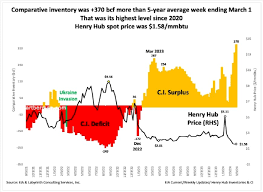Understanding Natural Gas Inventory and Its Market Impact

Importance of Natural Gas Inventory
Natural gas inventory plays a crucial role in the energy market, influencing pricing and supply chain dynamics. As countries transition to cleaner energy sources, understanding the fluctuations in natural gas supply is vital for energy producers, consumers, and policymakers alike.
Current State of Natural Gas Inventory
As of October 2023, the Energy Information Administration (EIA) reported that the United States’ natural gas inventory stands at approximately 3.4 trillion cubic feet (TCF), which is about 6% above the five-year average. This higher-than-average inventory is attributed to a mild summer that reduced demand for air conditioning and a significant increase in domestic production.
Natural gas prices have reacted to these inventory levels, with spot prices in the Henry Hub trading around $2.50 per million British thermal units (MMBtu), showing a decrease compared to the previous year. Analysts suggest that if inventory levels remain high, it could exert downward pressure on prices throughout the winter months, especially if weather forecasts predict a warmer-than-average winter.
Factors Influencing Natural Gas Inventory
Several factors affect the natural gas inventory, including production rates, consumption levels, and seasonal demand. The rise in liquefied natural gas (LNG) exports from the U.S. has also contributed to changes in inventory dynamics. With several new terminals coming online, there is a heightened interest from international markets, which could lead to fluctuations in domestic supply as producers adjust to meet foreign demand.
Future Outlook
Looking ahead, experts predict that inventory levels will continue to fluctuate based on production rates and seasonal demand. The winter months are a critical period, as heating demand can deplete gas supplies quickly. Additionally, geopolitical developments, such as the ongoing Russia-Ukraine conflict, may impact global natural gas flows and prices.
Conclusion
The natural gas inventory is more than just a number; it is a critical indicator of market health and energy stability. As the world shifts toward sustainable energy practices, understanding its trends and implications becomes imperative for stakeholders involved in the energy sector. Keeping a close watch on inventory statistics will provide insights that can guide future investments and policy decisions.









